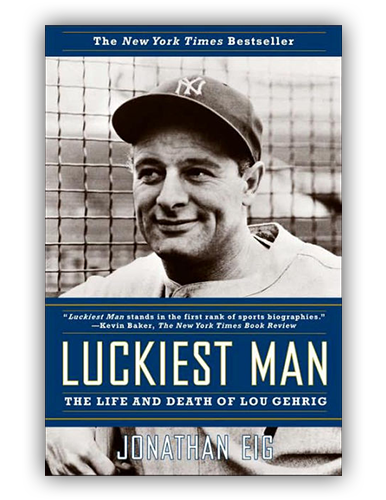LUCKIEST MAN
THE LIFE AND DEATH OF LOU GEHRIG

Baseball's Tragic Hero
Lou Gehrig was a baseball legend—the Iron Horse, the stoic New York Yankee who was the greatest first baseman in history, a man whose consecutive-games streak was ended by a horrible disease that now bears his name. But as this definitive new biography makes clear, Gehrig’s life was more complicated — and, perhaps, even more heroic — than anyone really knew.
Drawing on new interviews and more than two hundred pages of previously unpublished letters to and from Gehrig, Luckiest Man gives us an intimate portrait of the man who became an American hero: his life as a shy and awkward youth growing up in New York City, his unlikely friendship with Babe Ruth (a friendship that allegedly ended over rumors that Ruth had had an affair with Gehrig’s wife), and his stellar career with the Yankees, where his consecutive-games streak stood for more than half a century. What was not previously known, however, is that symptoms of Gehrig’s affliction began appearing in 1938, earlier than is commonly acknowledged. Later, aware that he was dying, Gehrig exhibited a perseverance that was truly inspiring; he lived the last two years of his short life with the same grace and dignity with which he gave his now-famous “luckiest man” speech.
Meticulously researched and elegantly written, Jonathan Eig’s Luckiest Man shows us one of the greatest baseball players of all time as we’ve never seen him before.
Why Gehrig?
I was reading Laura Hillenbrand's brilliant book, Seabiscuit, when it hit me: the best sports books are always about more than sports. Probably should've figured that out a lot sooner, but, yeah...
So I tried to break it down. What made Seabiscuit so good, and, more important, once I cracked Hillenbrand's formula for success, how could I copy it? That's how I got to Gehrig. Like Seabiscuit, he competed through the Great Depression. Like Seabiscuit, he overcame adversity and became the kind of hero that transcends ordinary competition. Also like Seabiscuit, he didn't talk! Which became a problem for me, actually. Lou was so shy that he seldom gave interviews and never wrote a memoir. If he wrote letters, few seemed to survive. Athletes, as a rule, are not the best record keepers, I learned. He wasn't making it easy for his future biographer.
I've been a Yankee fan all my life. But, as a child, I overlooked Gehrig. He lacked the excitement of his teammate and pal Babe Ruth, or the grace of his later teammate Joe DiMaggio. All I knew was that he played every game and hit the ball like a rocket. To be honest, Gehrig puzzled me. So strong, so determined, so handsome...and yet so insecure. Why did he seem so afraid of women? Why was he so attached to his mother? Just a few years after he finally seemed to be overcome his awkwardness, just when he found love, at age 30, he began to show signs of the illness that would take his life, amyotrophic lateral sclerosis, or ALS.
He was baseball's Iron Horse. He played 2,130 consecutive games. But ALS slowly began to melt his muscles. Though he played the entire 1938 season and helped the Yankees win the World Series, he knew something was wrong. How did he handle it? How did he take the news that he would not likely live to see his 40th birthday? How would I figure it out? I knew I couldn't tell his story the way it deserved to be told unless I understood how he faced his disease -- and his mortality.
After years of research, I made one of the most thrilling discoveries of my life as a writer: more than 200 pages of letters Gehrig wrote to his doctor over the final two years of his life.
At last, I could take the true measure of the man. And I discovered that Gehrig was a greater hero than I'd ever imagined.






